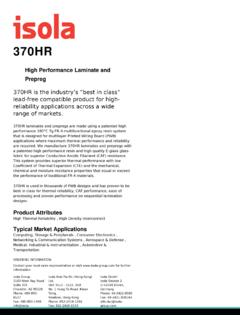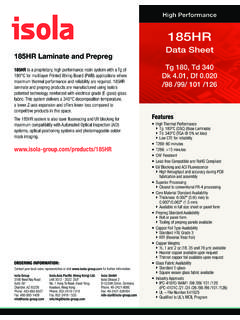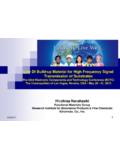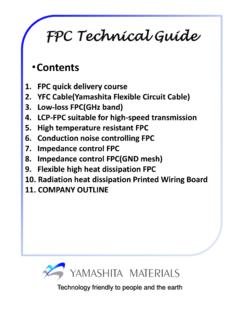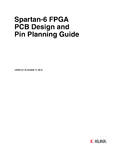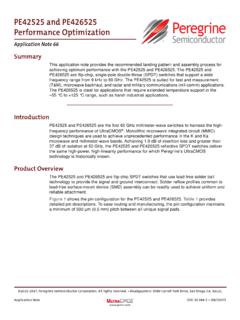Transcription of Developments in Glass Yarns and Fabric Constructions - Isola
1 78 The PCB Magazine March 2014 Featureby Alun Morganisola group europeDevelopments in Glass Yarns and Fabric ConstructionsGlass fibres are nothing new; the ancient Egyptians reportedly drew coarse fibres from heat softened Glass . Modern usage, however, began in the 1930s with the founding of the Owens-Corning Fiberglas Corporation and the granting in 1938 of a patent covering their commercial manufacturing exhibit markedly different properties to those of their bulk parent materials. Glass fi-bres can exhibit tensile strengths up to 5 GPa, which is around 100x higher than that of bulk Glass , the difference being attributable to the reduction of the effect of surface defects, the control of which remains an important perfor-mance use of woven Glass fibres in PCB sub-strates dates back to the 1960s where they were used as a high performance replacement for pa-per reinforcements.
2 Woven Glass fibre provided an ideal reinforcement to complement the prop-erties of epoxy resin systems which were being rapidly deployed in electronics by adding high tensile strength and dimensional stability to the composite material forming the fibres brought not only the properties of high tensile strength and dimensional stabil-ity but also high thermal resistance, good chem-ical resistance, insensitivity to moisture and of course that of being a good electrical process of Glass fibre production re-mained largely unchanged over 50 years, how-ever there have been a number of recent impor-tant Developments that have enabled substrates made with woven Glass fabrics to adapt to the changing requirements of circuit design.
3 In particular changes have been necessary to ac-commodate microvia technology requirements, improving CAF (conductive anodic filamenta-tion) requirements and very importantly to extending the usable frequency range of Glass reinforced substrates. To understand the Developments it is use-ful to review the process by which woven Glass fabrics are made. The process begins with a Glass formulation which is tailored for a particular application. Glass is formulated mainly of sili-80 The PCB Magazine March 2014con dioxide (Silica, SiO2), to which varying pro-portions of principally metal oxides are added (Table 1). Glass fibre reinforcements are named ac-cording to the properties imparted by these for-mulations, the letter designation being taken from a characteristic property: E- Glass is electri-cal grade and has a low alkali content.
4 It exhibits excellent electrical insulation and low moisture absorption. E- Glass accounts for the majority of Glass fibre production used for reinforcement. D- Glass has a low dielectric constant (Dk), how-ever its mechanical properties are not so good as E- or S- Glass . C- Glass is chemical Glass , having very high chemical resistance and S- Glass is a high-strength Glass having a much higher ten-sile strength than that of E- Glass . This list is not exhaustive and there have been recent variants having similar properties to D- Glass which will be discussed Glass formulation is melted in a fur-nace and the molten Glass is then mechanically drawn into single filaments through small holes in a platinum/rhodium alloy bushing.
5 The fila-ments are next gathered into bundles called strands and are then coiled onto bobbins to form a yarn (Figure 1). During the strand form-ing process a size is applied in order to protect the Glass surface to avoid the formation of de-fects that would weaken the fibres. The individual filaments for PCB substrate use are commonly between 5 and 9 microns in diameter and are gathered together into stands of between 204 and 408 filaments to form a yarn , see Table 2. It is interesting to note that 1 square foot of Glass fibre reinforced PCB laminate contains over 500 miles of individual Glass filaments. The Yarns have individual des-ignations, shown in Figure 2.
6 Table 1: Glass composition main ingredients, by weight%.Figure 1: Glass yarn IN Glass Yarns AND Fabric Constructions continuesMarch 2014 The PCB Magazine 81 The first part of the weaving process is called warping, which is the operation through which the yarn on the bobbins is transferred to section beams at the required spacing to form the warp threads which run in the machine direction and are up to 3 kilometres in length. Depend-ing on the total number of threads required for a given type of Glass weave (style), several sec-tional beams are produced and consolidated in a group called a set which is the input for the slashing process where additional size is added to protect the fibres from breakage through the weaving the loom beam is installed on the weaving loom, Fabric is formed by interlacing filling Yarns (picks, weft threads) orthogonal to warp threads (ends) (Figure 3); the most com-mon interlacing of fill and warp ends (weave pattern) is plain weave although others such as basket, twill and satin are available.
7 The woven Fabric is wound onto a roll for subsequent heat cleaning to remove the size and then onto fin-ishing operations. In order to provide maximum adhesion of the Fabric to the various resins matrices, a coupling agent (finish) is applied to the Fabric by impregnating in a finish bath ; additionally proprietary fibre spreading treatments can also be applied at this stage. The resultant plain weave Fabric is shown in Figure Yarns are combined in different combinations to weave the variety of styles that are subsequently used for PCB substrate production. Table 3 shows the composition of the traditional styles 2: Glass yarn common 2: Glass yarn IN Glass Yarns AND Fabric Constructions continues82 The PCB Magazine March 2014 Next, we must look in detail at the woven Glass Fabric and to consider the inherent limita-tions placed on PCB performance and design.
8 The traditional Glass cloth styles and their com-position were originally chosen with thickness yield, ease of manufacture and mechanical properties as the primary drivers. There was lit-tle concern at the time to consider the effects of inhomogeneity in the resultant PCB substrates, indeed this did not matter greatly in terms of the PCB technology of the day. Considering that the PCB substrate is a com-posite material comprising a resin system and a woven Glass reinforcement it is necessary to un-derstand how the properties of the component parts affect the behaviour of the whole, bear-ing in mind that the macro and micro behav-iour may also differ. Referring to Figures 5 and 6, the reducing density of the Glass fibre matrix with decreasing thickness can be clearly seen.
9 The picture of 106 style Glass Fabric in Figure 6 demonstrates that for this style over 40% of the available area is occupied with gaps in the Glass fibres which will be filled with resin in the resulting substrate. The issue we must explore is the interaction of a signal transmitted on the conductive layer with the micro structure of the substrate conductive feature sizes decreasing these are now of the same order as the features arising from the weave pattern leading there-fore to opportunities of interaction. The speed of the electrical signal, which is actually the speed of the associated electromagnetic wave, can be considered by calculating the velocity factor which is the speed at which a signal pass-es through the medium relative to the speed of light.
10 The velocity factor is expressed as the re-ciprocal of the square root of the dielectric con-stant of the transmission dielectric constant of E- Glass is around , whereas the dielectric constant of a typical epoxy resin is around From these figures we Figure 3: Glass weaving 4: plain weave IN Glass Yarns AND Fabric Constructions continuesMarch 2014 The PCB Magazine 83can now calculate the velocity factor for a con-ductor placed directly over a Glass fibre yarn as the speed of light and that of a conduc-tor placed in area containing only resin as the speed of light. These values represent the ex-tremes, however the difference is massive. The use of differential pairs in signalling is very com-mon in order to eliminate common electromag-netic noise, the transmitted information being the difference between the traces which contain equal amplitude but opposite polarity signals.





